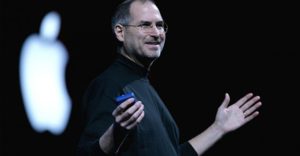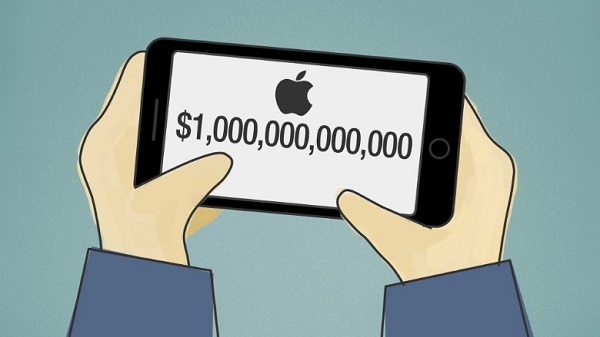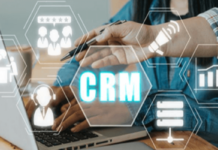With its share price soaring to an all-time high, Apple has now become the first ever public sector company to reach a market valuation of 1 trillion dollars. While you try to figure out just how many zeros follow 1 in that sum, should you also know that this is the same company who battled the brink of bankruptcy in 1997. Over 20 years since then – and an eternity long legacy of Steve Jobs – few would have really thought that Apple would emerge to be a culture-definingentity, literally pushing human race ahead. After all, they started as just another computer manufacturer.
The Apple Journey

You know the story is epic when tens of movies are made, and books are written, on it. But, in case, if you’ve missed the outstanding titular performance of Michael Fassbender in ‘Steve Jobs’ (2015 movie), here’s a quick but detailed look-back at the memory lane:
- A college dropout and working at a gaming company, Steve Jobs incorporated Apple Computer on April 1, 1976, along with two of his friends: Steve Wozniak and Ronald Wayne. However, soon after 3 months, the friendship among three turned sour; Wayne sold his shares at just $800 and left the company.
- Apple I, the first ever Apple computer was first introduced in Job’s parent’s garage in Cupertino, California. A local computer store managed to sell more than 200 units of Apple I. Then came Apple II in 1977, which was billed as the first personal computer for the masses. It sold decently; not as exceptional as the founders wanted it to though. However, innovation continued at the company with Apple Disk II, ProFile hard disk, and home printers.
- In 1983, Apple launched Lisa, a new brand of personal computers that offered a graphical However, as it turned out, Lisa soon tanked. However, what came out next would revolutionize the entire computing world—Macintosh, the first-ever affordable computer (priced at $2,495) to offer graphical interface. The computer was launched with this now-iconic commercial-
- However, even with an outstanding product, things weren’t exactly very good at the company. Financially, it was struggling. Then in the mid-80s, the news came like a jolt to the public, Steve Jobs had to leave a company that he once created. He was ousted by his own people. Steve Wozniak, too, followed Jobs and left the company. The founders were now out.
- In the following years, Apple kept on launching new products. Portable computers seeped well into our lifestyles. And the computing world was seeing some big changes. However, in the closed rooms, with stiff competition from Microsoft and HP, and without a competent leadership at the top, Apple continued struggling. It sustained big losses over the course. And in 1997, the company was strides away from bankruptcy. But then something happened…
- Steve Jobs made a comeback in his company. Apple’s board made that decision to have him onboard. What came next was a succession of big decision-making in the company and even bigger changes that steered Apple on the path where it is currently on. In the next 15 years, Jobs, true to his original words, went on to “put a ding in the world”.
- OS X was launched, iBook came into existence (which dwindled in 2006). MacBook continued improving. A line of products was launched in the following years—iPhoto, iMovie, iTunes, iPod, and more. BUT it was really 2007 that changed the entire landscape for Apple. On June 29, 2007, Steve Jobs stood before the world and launched the first ever iPhone. And that was the beginning of the ‘Smartphone era’.
- In the next few years, Apple launched Macbooks, Tablets, iPads and, of course, the badass that we now know as Siri. It continued on its path of innovation. BUT, in place of being rewarded as generation’s biggest revolutionary and entrepreneur, there was something totally different in store for co-founder Steve Jobs. He was diagnosed with pancreatic cancer. And over the months, his situation worsened. He resigned from the company on August 24, 2011. Steve Jobs died on October 5, 2011.
- Even after Jobs gone, Apple continued progressing in the tech world. In 2012, it became the world’s most trusted brand. In 2014, it became the first US company to be valued at over $700 billion. The company launched a chain of retails around the world that stood at 463 in number till 2015. As it stands now, Apple now has 1.3 billion active devices worldwide, with a total of over 12 billion iPhones sold since 2007.
- All these achievements, all these struggles, and all the sacrifices on the core team’s part now has led Apple to become the first ever public sector company to be valued at more than $1 trillion. A monumental story really! (Remember, there’s a reason why millions of entrepreneurs around the world look up to Steve Jobs.)

Is it too high to touch?
Following the latest grand feat, the hushed talk, in the Silicon Valley, in particular, is now centered whether the iPhone makers have set the bar too high for others to match. You can easily antedate the risen brows at Amazon, Alphabet, and Microsoft, all of which are right behind in the ranking but with a large margin in between.
Indeed, a trillion mark is grandeur in every dimension. But so was the one and a hundred billion USD marks when first crisscrossed. In 1901, US Steel Corporation became the first company to touch the market valuation of one billion US Dollar. 86 years later, in 1987, IBM became the first ever $100 billion company. Both the figures, once, looked too big to touch. Could this be the same with the latest 1-trillion-Apple-feat? The tech-giant has perhaps opened a new door for others to barge in.
Theory (And Practical)
Theoretically, with ambitions high and the right strategy, any company can grow to touch the trillion-mark. But in practical terms that are more inline with the world’s reality, the task-at-hand is extremely tough. Feasibly not for the giants in the upper echelon like Google, Microsoft, Facebook and Berkshire Hathaway, but at least for thousands and thousands of other companies who are just as innovative and culturally impactful as Apple.
Think about it. There would be a time when entrepreneurs chased the dreams to create a million-dollar company. And then came an off-spring of new-age entrepreneurs who pursued billion-dollar companies on their portfolio; very few in number, even fewer if you’re counting those really did turn that aspiration into reality. And now we’re here, at this terminus, with the first ever public sector company with a valuation of over $1 trillion. Could we really imagine a very small population of elite dreamers who could possibly dare to chase this trillion-dollar ambition? Very unlikely.
The Motivational Ones
Building a business comes with a natural lifecycle that no amount of grind can shorten. This is exactly why patience still stands as one of the cornerstones to successful entrepreneurship. Apple is built over generations. Of course, there are plenty of exceptions to this traditional theory. We’ve heard stories of how Groupon made over a billion-dollar in revenue in just 2.5 years, how Pierre Omidyar and Mark Zuckerberg took just 3 and 4 years respectively for their personal valuation to cross USD 1 billion mark.
A Happy Note…
However, even when soaking the motivation from such aspiring stories, the idea of a one-trillion-dollar-company still is far-fetched for even the brightest of entrepreneurs. That’s six added zeros following one million—a now-small territory that so many of us still chase. But let’s not end on a morose note and let’s give practicality a minute of rest. The team at Apple has done it. And so can anyones. In the end, these are just numbers that are set to be crossed. Million, billion, trillion or even quadrillion—no figure can really constrain a big idea, bigger goal, and biggest commitment.








